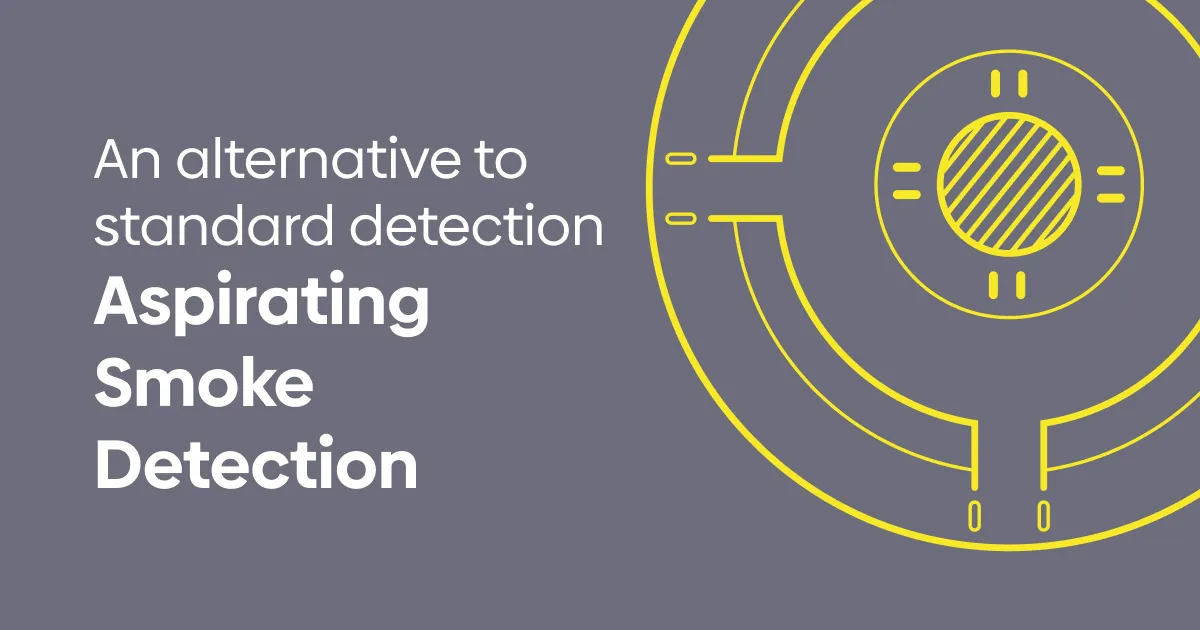
When a fire engineer walks into a 15-metre-high warehouse, a sub-zero cold store or a heritage site, they’re immediately confronted with the same problem: how do you reliably detect smoke in an environment where conventional point detectors struggle or fail completely?
The answer lies in aspirating smoke detection (ASD) – a technology that actively samples air through a network of pipes, detecting smoke particles long before they’re visible to the naked eye. But the real story isn’t just about the technology itself. It’s about the remarkable breadth of challenging applications where ASD has become the only viable solution.
Beyond the Basics: Where Conventional Detection Fails
Standard smoke detectors work brilliantly in typical commercial spaces. However, the UK fire and security industry increasingly faces projects where these conventional solutions simply aren’t viable. In environments with ceiling heights exceeding 10 metres, building regulations and British Standards prohibit relying on standard point detection alone. In sub-zero temperatures, conventional detectors cease to function reliably as condensation freezes in optical chambers and smoke lacks sufficient thermal energy to rise. Add to this projects where aesthetic requirements demand invisible protection – such as listed buildings or prestigious commercial spaces – and it becomes clear that many modern applications fall outside the scope of conventional detection entirely.
Aspirating smoke detection solves this by bringing the air to the detector, rather than waiting for smoke to reach a fixed point. Through a network of sampling pipes with precisely positioned holes, ASD systems actively draw in air samples, analyse them in a highly sensitive detection chamber and provide a warning at the earliest stages of fire development. In many cases, this means detection during the smouldering phase, long before flames appear.
The Surprising Range of Applications
What makes ASD particularly valuable to installers is its versatility. From heritage buildings to heavy industry, the same fundamental technology adapts to vastly different challenges:
Heritage and Historic Buildings – Installing conventional detectors in churches or museums presents an impossible choice: compromise the aesthetics or compromise the protection. ASD systems solve this elegantly. Sampling pipes can be concealed behind ceilings and walls, keeping visual impact to an absolute minimum, whilst the detector unit itself sits in a plant room or other accessible location.
Cold Storage and Freezer Warehouses – At -25°C, conventional detectors face multiple challenges: condensation forms on optical chambers, smoke lacks the thermal energy to rise effectively, and maintenance access requires costly shutdowns. ASD overcomes all three issues. The detector unit sits outside the cold zone in an ambient-temperature location, whilst specially designed sampling pipes with heat trace capabilities ensure reliable operation regardless of temperature. For cold storage operators, this translates directly to reduced insurance premiums and elimination of false alarms from condensation.
Data Centres and Server Rooms – A single rack of servers can represent millions of pounds of equipment and business-critical operations. Data centre operators need the absolute earliest warning possible – ideally detecting overheating equipment before it produces visible smoke. ASD systems configured for very early smoke emission response can detect a smouldering cable or overheating component when smoke levels are measured in parts per million. This provides time to investigate and shut down affected equipment before triggering gas suppression systems.
Clean Rooms and Pharmaceutical Manufacturing – In environments where air quality must meet ISO Class 5 standards or better, introducing any contamination is unacceptable. ASD systems protect clean rooms without compromising their integrity. All control equipment and test points are located outside the controlled environment, whilst sampling pipes use intumescent collars to maintain fire compartmentation. For pharmaceutical manufacturers, this approach satisfies both fire safety requirements and Good Manufacturing Practice (GMP) compliance.
Warehouses and High-Bay Storage – The rise of e-commerce has driven demand for increasingly tall automated warehouses, often exceeding 20 metres in height. At these heights, standard point detection is no longer acceptable under British Standards and even where permitted at lower heights, smoke stratification becomes a serious concern – smoke spreads horizontally along thermal layers rather than rising to ceiling level, causing significant detection delays.
ASD systems overcome both challenges through their active air sampling approach. Vertical sampling pipes can be positioned at multiple heights (typically at 3-8 metre intervals), effectively creating a three-dimensional detection grid that captures smoke regardless of stratification effects. This proactive sampling reduces the delays inherent in waiting for smoke to reach high-level detectors, whilst the cumulative effect of multiple sampling points and very high sensitivity makes effective secondary detection possible even in the most challenging warehouse environments.
Transport Infrastructure and Tunnels – Railway stations, airport terminals and road tunnels present unique challenges: high air movement, large volumes and the critical need to maintain operations. ASD systems cope with air velocities that would render point detectors ineffective, actively drawing in samples regardless of airflow patterns. For rail operators, this reliability translates to reduced service disruptions and enhanced passenger safety.
Industrial and Manufacturing Environments – Recycling plants, paper mills, and textile facilities share common characteristics: dusty environments that generate frequent false alarms from conventional detectors. Modern ASD systems incorporate sophisticated algorithms that distinguish between dust particles and genuine smoke signatures. The Kidde ModuLaser range, for example, uses laser-based particle analysis to dramatically reduce nuisance alarms whilst maintaining sensitivity to actual fire conditions.
For particularly harsh environments, external filtration can be incorporated into the sampling pipework itself. This approach captures larger dust particles before they reach the detection chamber, extending both filter life and maintenance intervals whilst preserving the system’s sensitivity to genuine smoke particles. Combined with the ModuLaser’s wastegate technology – which passes only a small representative sample of air through the detection chamber – even heavily contaminated industrial environments can achieve reliable fire detection without the constant false alarms that plague point detector installations.
Lift Shafts and Elevator Systems – Lift shafts present one of the most challenging environments for conventional detection. The movement of lift cars creates transient pressures (the “piston effect”) that cause highly variable airflow patterns, whilst vibration, dust accumulation and humidity can trigger false alarms or detector failure. Maintenance access requires costly lift shutdowns and places technicians in hazardous confined spaces at height.
ASD systems solve these challenges elegantly. The detector unit sits in an accessible machine room or plant room, whilst sampling pipes with strategically positioned holes draw air from multiple shaft levels. For buildings up to five floors, holes at the top of the shaft typically suffice; taller buildings benefit from vertical sampling pipes with holes at each floor level, creating comprehensive coverage that overcomes smoke stratification. Modern systems like ModuLaser include flow fault delay features that prevent nuisance alarms from normal lift car movement.
The Technical Advantages That Matter
Understanding why ASD suits such diverse applications requires looking at the fundamental advantages:
Extreme Sensitivity – ASD systems detect smoke at concentrations thousands of times lower than point detectors. This isn’t just about earlier warning – it’s about detecting fire conditions that simply wouldn’t trigger conventional detection for minutes or hours.
Active Air Sampling – Rather than passively waiting for smoke to arrive, ASD systems continuously draw in air samples. This overcomes issues with stratification, dilution and poor air movement that plague passive detection methods.
Remote Detection Units – Locating the detector away from the protected space solves multiple problems simultaneously: maintenance becomes straightforward, harsh environments don’t affect detector reliability, and aesthetically sensitive spaces remain uncluttered.
Configurable Sensitivity – The same ASD system can operate at sensitivities ranging from ultra-early detection (0.001% obscuration per metre) to reduced sensitivity for dusty environments (1% obscuration per metre). This flexibility allows one technology to adapt to vastly different requirements.
Minimal Maintenance Requirements – With detectors located in accessible positions and modern wastegate technology reducing contamination, ASD systems typically require servicing just once or twice annually. For sites with difficult access – offshore platforms, high-bay warehouses, or historic ceilings – this dramatically reduces lifecycle costs.
Selecting the Right System for the Application
Not all ASD systems are created equal, and matching technology to application is crucial. The Kidde ModuLaser range exemplifies modern ASD design, offering features specifically developed for challenging UK applications:
ClassiFire Algorithm – This advanced software analyses smoke particle characteristics to distinguish between genuine fire signatures and environmental contaminants. For dusty industrial environments, this feature alone can eliminate 90% of false alarms.
Reference Detector Technology – By continuously comparing protected space air to ambient air, the system automatically compensates for background conditions. This proves invaluable in environments with variable contamination levels.
Wastegate Technology – Only a small representative air sample passes through the detection chamber, dramatically extending maintenance intervals even in dirty environments. For installers, this creates a compelling lifecycle cost argument.
MatrixScan Capability – Multiple pipes can be individually monitored, creating virtual detectors at specific locations. When combined with building management systems, this enables automated responses tailored to the fire location.
Taking the Next Step
Aspirating smoke detection has evolved from a niche technology for high-risk applications into a mainstream solution for any environment where conventional detection struggles. For installers, developing ASD expertise opens opportunities in areas ranging from heritage protection to industrial manufacturing, from cold storage to data centres.
The breadth of applications reflects a fundamental truth: when projects demand the earliest possible warning, the highest reliability, or solutions to seemingly impossible installation challenges, aspirating detection delivers results that conventional technology simply cannot match.
Ready to explore how ASD could benefit your next project? Our technical team at Huvo can provide application-specific guidance, system sizing and design support to help you specify the optimal solution. Whether you’re protecting a medieval cathedral or a modern automated warehouse, we’ll ensure your ASD installation delivers reliable protection for decades to come.








